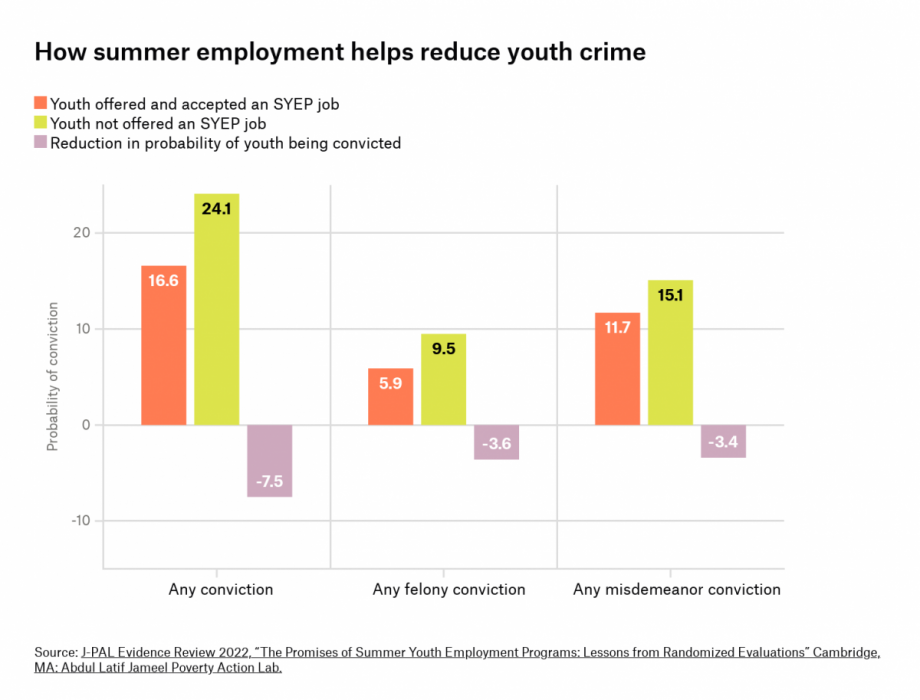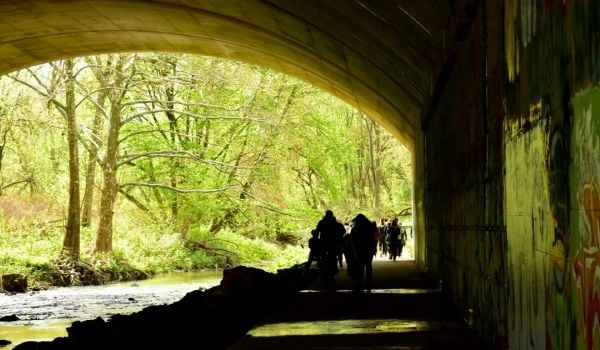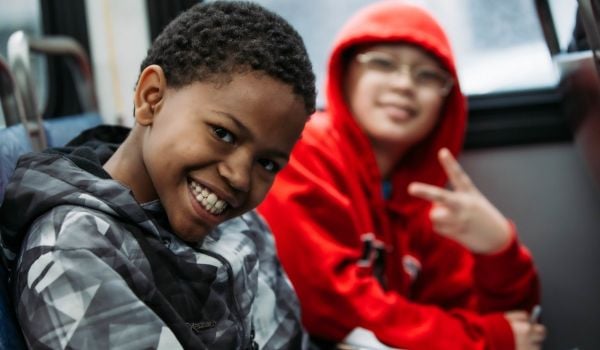This story was originally published on Vital City.
The end of the school year marks the beginning of summer and with it, the hunt by many teenagers for a summer job. With the continued red-hot U.S. labor market, unemployment among 16- to 19-year-olds is at its lowest rate since 1953, meaning many teenage job-seekers have a good chance of landing a job right now. But the overall rosy summer jobs outlook this year masks the fact that not all teenagers are experiencing the benefits of this strong job market equally. The May jobs report confirmed that current unemployment rates among Black (11.7%) and Hispanic (10.1%) youth remain higher than those of their white peers (9.1%).
Why is having a summer job so important? Early work experience plays an essential role in building both soft and hard skills for future career success. Employers have high expectations for work readiness, communication and other “soft” skills that are difficult for youth to demonstrate without a track record of work experience. Inequities early on ripple into adulthood.
To level the playing field, many cities across the U.S. host summer youth employment programs (SYEPs) to connect low-income inner-city youth to positions they might not have access to on their own. These programs can be quite large in scale and range in size, with roughly 7,000 to 10,000 youth employed each summer in cities such as Boston and Chicago to upwards of 100,000 in New York City. Most programs are oversubscribed, meaning that they have more youth applicants than jobs to fill. For example, it’s estimated that New York would need to expand the number of slots to 150,000 to meet the need to make the program universal.
While specifics vary, these popular programs generally place young people, ages 14-24, in part-time jobs at city agencies, community-based nonprofits or private sector employers. Applicants are primarily from low-income neighborhoods and the majority of participants are Black or Hispanic. Youth typically work a maximum of 25 hours per week for a six-week period from early July through mid-August and are paid the minimum wage. Programs often include career readiness training, financial literacy and social-emotional curriculum while promoting mentorship opportunities with supervisors and adult coworkers.
With a price tag of roughly $2,500 per participant, cities are often constrained by a lack of funding. In the early 1990s, federal funding for SYEPs largely ended on the assumption that in a full-employment economy, employers would hire youth without any government subsidy. Some large city mayors pulled together funds from various sources to sustain their programs, recognizing that inner-city youth rarely get hired even in the best economic times. But program slots have not been sufficient given a rising minimum wage and growing applicant pools. Fortunately, some mayors, including Eric Adams in New York, have recently invested COVID-relief funds from the American Rescue Plan to expand their programs.
Unfortunately, few of these programs have been made a dedicated line item in state and local budgets to sustain these gains once the federal funding expires. Given the many proven benefits of SYEPs, lawmakers should reverse course — and take a series of other steps to keep young people productively engaged in the summer months.
The evidence
For youth who participate in SYEPs, having a summer job can mean much more than just a rite of passage: Research shows that summer jobs programs benefit both participating youth and their communities.
How do we know this? Because the number of applicants exceeds the number of jobs every year, many cities assign participation using a lottery. This means researchers can compare participants to a random set of similar applicants who did not win spots in the program. These randomized evaluations of summer jobs programs from across the U.S. have demonstrated that summer jobs programs are a cost-effective way of improving a wide range of youth outcomes related to employment, education and criminal justice involvement.
Studies from Boston, Chicago and New York consistently show that SYEPs provide employment and additional income to youth who would otherwise have difficulty finding a job during the program summer. On average, 70% to 80% of youth offered a slot through an SYEP lottery worked at a job during the summer. Less than 30% of those not offered a slot, who had to then find a job on their own, did.
The benefits didn’t stop there. In Boston, both employment and wages were higher during the year following the program for Black male participants aged 19 to 24 years relative to their peers in the control group. In New York City, providing youth with a letter of recommendation from their summer job supervisor improved future employment outcomes.
It’s a virtuous cycle: As SYEPs expose youth to careers that raise academic aspirations while developing better work habits such as being on time and working in a team, that pays dividends in better academic performance. Researchers found that New York City’s SYEP led to better attendance and test scores during the school year. On average, those who benefited the most were youth of legal dropout age and youth who had a higher rate of school absences prior to program participation. In Boston, these improvements have been shown to lead to a 4 percentage point increase in on-time high school graduation.
Perhaps the most consistent benefit of SYEPs is the way they reduce criminal activity: providing youth with socially productive activities during the summer that have been linked to a reduction in criminal justice involvement. For example, the Chicago program was associated with a 43% drop in violent crime in the 16 months after participating in the program. In Boston, both violent and property crime rates dropped by 30-35% over a similar time period for program participants. In New York City, researchers found that the SYEP reduced incarceration and mortality from “external causes,” including homicides, suicides and accidents.
What is even more surprising is that the program’s effects on reducing crime persisted beyond the summer months, suggesting that something beyond keeping youth “busy” during the summer could be at play. In Boston, improvements in community engagement and soft skills — such as managing emotions, resolving conflict with peers and asking for help — were associated with a larger reduction in criminal arraignments, rather than job readiness or academic aspirations. These findings suggest that the program’s criminal justice impacts stem more from social and emotional development rather than improving human capital and employment opportunities.

Finally, these benefits accrue not just to youth but also to their families and communities in tangible ways. Add it all up, and studies show that the benefits of reduced crime, increased high school graduation and higher employment exceed program costs by a factor of 3-to-1. Not to mention that nearly half of all youth use some portion of their summer earnings to pay a household bill, providing needed support for low-income families. And many summer camps in big cities simply could not run without the low-cost labor supported by the summer jobs program, providing low-cost daycare to entire communities of working parents.
The way forward
As we continue our third summer shaped by the pandemic, which separated young people from their support systems in so many distressing ways, cities should think more broadly about SYEPs as critical touchpoints in the lives of young people.
As the economy continues to rebuild, it is also imperative that we do not merely return to the unequal employment reality of pre-pandemic America. To truly build back better, cities should prioritize an equitable economic recovery by ensuring that good summer jobs are accessible to young people of color and young people from low-income families.
Here are a few concrete suggestions to make that happen:
- Make use of those ARPA dollars. American Rescue Plan funds that flowed to states and localities included $350 billion in flexible money, some portion of which could be directed toward youth programs. Another $22 billion went to local education agencies to be targeted for after-school, summer and extended learning time activities. Using even a relatively small allocation of these dollars, state and local leaders can expand employment opportunities so that programs can meet the needs of all youth applicants, not just those lucky enough to win the SYEP lottery.
- Build a better infrastructure to expand opportunities. SYEPs can lay an even stronger foundation for broader success if cities build better connections between summer and year-round employment programs, full-time work, community college enrollment and/or apprenticeships. It’s time for cities to seize this moment to build a more holistic youth workforce development system that blends together both education and work-related experiences that can be sustained beyond the currently strong job market.
- Leverage the private sector. SYEPs are often heavily reliant on the public and nonprofit sectors. In New York, most SYEP participants (73%) were placed with nonprofit organizations and nearly half (46%) worked for summer camps or day care programs. In contrast, the Boston Private Industry Council, the city’s workforce board and school-to-career intermediary, typically secures upward of 2,600 unsubsidized jobs from local employers. Cities can get the private sector more involved in the program by highlighting the benefits of participation, such as diversifying their workforce, or even better, using some of their ARPA funding to provide a sliding subsidy for youth wages while employers test the waters before signing on to foot the costs.
- Focus on job quality. The greatest SYEP impacts come from having a meaningful employment experience that includes both soft and hard skills, mentorship and career readiness. Cities should ensure that more young people get placements that yield a digital badge, high school credit or even a recognized credential. That will raise job quality, enable youth to ladder experiences across summers and signal to future employers that young people are job-ready.
- Address the youth mental health crisis. Young people have suffered more than any group during this pandemic with the loss of academic and extracurricular activities, social engagement and important “firsts.” Eating disorders, depression and suicide are by some measures at all-time highs. While studies have shown improvements in mental health for youth who are placed in a job, cities can further enhance those outcomes by building additional services into their programs.
- Pioneer new models. The experiences of some cities in preserving and expanding their SYEPs during COVID spurred important innovations. For example, during the summer of 2020, Boston developed four new tracks of programming, including a Summer Learn and Earn program, which enrolled students in college-level courses to earn credit and gain certifications. Nearly 90 percent of youth enrolled in the Learn and Earn program completed their courses, and nearly 80 percent passed their courses for credit. This suggests that cities need to expand their definition of what counts as a summer experience to foster all kinds of youth development, not just youth workforce development.
SYEPs have laid a solid foundation for cities to help young people — especially disadvantaged young people — grow into thriving adults. They should build on them.
Alicia Modestino is the executive director of Community to Community, a new research initiative at Northeastern University that uses data and analysis to design, implement and evaluate urban public policies.
















